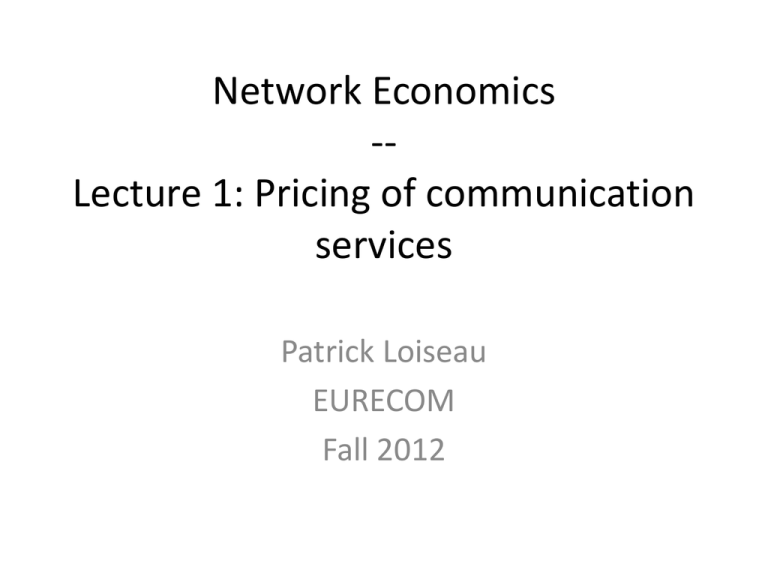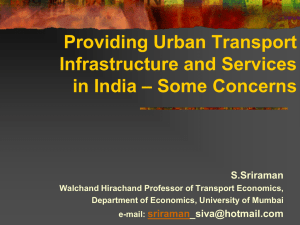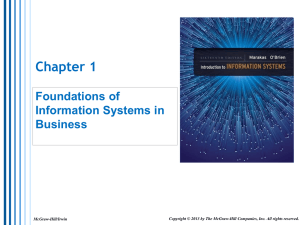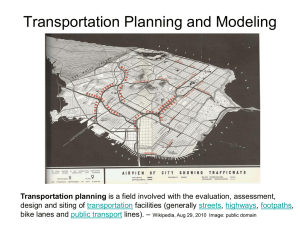Pricing of communication services
advertisement

Network Economics
-Lecture 1: Pricing of communication
services
Patrick Loiseau
EURECOM
Fall 2012
References
• M. Chiang. “Networked Life, 20 Questions and Answers”, CUP 2012.
Chapter 11 and 12.
– See the videos on www.coursera.org
• J. Walrand. “Economics Models of Communication Networks”, in
Performance Modeling and Engineering, Zhen Liu, Cathy H. Xia
(Eds), Springer 2008. (Tutorial given at SIGMETRICS 2008).
– Available online:
http://robotics.eecs.berkeley.edu/~wlr/Papers/EconomicModels_Sigm
etrics.pdf
• C. Courcoubetis and R. Weber. “Pricing communication networks”,
Wiley 2003.
• N. Nisam, T. Roughgarden, E. Tardos and V. Vazirani (Eds).
“Algorithmic Game Theory”, CUP 2007. Chapters 17, 18, 19, etc.
– Available online:
http://www.cambridge.org/journals/nisan/downloads/Nisan_Nonprintable.pdf
Content
1. Introduction
2. The effect of congestion
3. Time dependent pricing
– Parenthesis on congestion games and potential
games
4. Pricing of differentiated services
Content
1. Introduction
2. The effect of congestion
3. Time dependent pricing
– Parenthesis on congestion games and potential
games
4. Pricing of differentiated services
Examples of pricing practices
• Residential Internet access
– Most forfeits are unlimited
• Mobile data plans
– AT&T moved to usage-based pricing in 2010
• $10/GB
• Stopped all unlimited plans in 2012
– Verizon did the same
– In France: forfeits with caps (e.g. 3GB for Free)
Why were there unlimited plans
before?
• Unlimited plans called flat-rate pricing
• Users prefer flat-rate pricing
– Willing to pay more
– Better to increase market share
– http://people.ischool.berkeley.edu/~hal/Papers/b
rookings/brookings.html
• The decrease in the cost of provisioning
capacity exceeded the increase in demand
Why are providers moving to usagebased pricing?
• Demand is now growing faster than the
amount of capacity per $
• Distribution of capacity demand is heavytailed: a few heavy users account for a lot of
the aggregate
How to balance revenue and cost?
• Usage-based pricing
• Increase flat-rate price
– Fairness issue
• Put a cap
• Slow down certain traffic or price higher premium
service
– Orange has a forfeit for 1000 Euros / month, all
unlimited with many services. Their customers (about
1000 in France) got macarons to apologize for the
disruption in 2012.
Generalities on setting prices
• Tariff: function which determine the charge
r(x) as a function of the quantity x bought
– Linear tariff: r(x) = p x
– Nonlinear tariff
• Price design is an art, depends on the context
• 3 rationales
– The price should be market-clearing
– Competition, no cross-subsidization
– Incentive compatibility
Regulations
• Prices are often regulated by governments
– Telecom regulators ARCEP (France), FCC (USA)
– ≈ optimize social welfare (population + provider)
• Network neutrality debate
– User choice
– No monopoly
– No discrimination
•
•
•
•
Provider-owned services
Protocol-level
Differentiation of consumers by their behavior
Traffic management and QoS
• Impact on peering economics
Modeling: consumer problem
• Set of consumers N = {1, …, n}
• Each consumer chooses the amount x
consumed to maximize its utility – cost
• Under linear tariff (usage-based price p)
xi (p) = argmax[ui (x) - px]
• Consumer surplus
x
CSi = max[ui (x) - px]
x
• u(x) assumed concave
Consumer utility
• Example: u(x) = log(x) (proportional fairness)
Demand functions
• Individual demand xi (p) = (ui¢)-1 (p)
• Aggregate demand D(p) = å xi (p)
iÎN
• Inverse demand function: p(D) is the price at
which the aggregate demand is D
• For a single customer: p(x) = u¢(x)
Illustrations
• Single user CS(p) =
ò
x( p)
0
p(x)dx - px
• Multiple users: replace u’(x) by p(D)
Elasticity
• Definition:
¶D( p) ¶p
e=
D( p) p
• Consequence:
• |ε|>1: elastic
• |ε|<1: elastic
DD
Dp
=e
D
p
Flat-rate vs usage-based pricing
• Flat-rate: equivalent to p=0
– There is a subscription price, but it does not play
any role in the consumer maximization problem
• Illustration
Examples of tariffs
• Many different tariffs
• Choosing the right one depends on context (art)
• More information:
– R. Wilson. “Nonlinear pricing”, OUP 1997.
Content
1. Introduction
2. The effect of congestion
3. Time dependent pricing
– Parenthesis on congestion games and potential
games
4. Pricing of differentiated services
The problem of congestion
• Until now, we have not seen any game
• One specificity with networks: congestion (the
more users the lower the quality)
– Externality
• Leads to a tragedy of the commons
Tragedy of the commons (1968)
• Hardin (1968)
• Herdsmen share a pasture
• If a herdsman add one more cow, he gets the
whole benefit, but the cost (additional
grazing) is shared by all
• Inevitably, herdsmen add too many cows,
leading to overgrazing
Simple model of congestion
• Set of users N = {1, …, n}
• Each user i chooses its consumption xi
• User i has utility
ui (x) = f (xi )- (x1 +... + xn )
– f(.) twice continuously differentiable increasing
strictly concave
• We have a game! (single shot)
Simple model: Nash equilibrium and
social optimum
• NE: user i chooses xi such that
f ¢(xi ) -1 = 0
• SO: maximize
å u (x) = å[ f (x) - (x +... + x )]
i
i
iÎN
iÎN
Gives for all i: f ¢(xi ) - n = 0
• Summary: xiNE = f ¢-1 (1)
SO
i
x
-1
= f ¢ (n)
1
n
Illustration
Price of Anarchy
Welfare at SO
• Definition: PoA =
Welfare at NE
• If several NE: worse one
SO
SO
f (x ) - nx
• Congestion model: PoA =
NE
NE
f (x ) - nx
• Unbounded: for a given n, we can find f(.)
such that PoA is as large as we want
• Users over-consume at NE because they do no
fully pay the cost they impose on others
Congestion pricing
• One solution: make users pay the externality
on the others, here user i will pay (n-1) xi
• Utility becomes
ui (x) = f (xi )- (x1 +... + xn )- (n -1)xi
• FOC of NE is the same as SO condition, hence
selfish users will choose a socially optimal
consumption level
• We say that the congestion price “internalizes
the externality”
Pigovian tax and VCG mechanism
• A. Pigou. “The Economics of Welfare” (1932).
– To enforce a socially optimal equilibrium, impose a
tax equal to the marginal cost on society at SO
• Vickrey–Clarke–Groves mechanism (1961,
1971, 1973): a more general version where
the price depends on the actions of others
– See later in the auctions lecture
Content
1. Introduction
2. The effect of congestion
3. Time dependent pricing
– Parenthesis on congestion games and potential
games
4. Pricing of differentiated services
Different data pricing mechanisms
(“smart data pricing”)
• Priority pricing (SingTel, Singapore)
• Two-sided pricing (Telus, Canada; TDC,
Denmark)
• Location dependent pricing (in transportation
networks)
• Time-dependent pricing
– Static
– Dynamic
Examples
• Orange UK has a “happy hours” plan
– Unlimited during periods: 8-9am, 12-1pm, 4-5pm,
10-11pm
• African operator MTN uses dynamic tariffing
updated every hour
– Customers wait for cheaper tariffs
• Unior in India uses congestion dependent
pricing
Different applications
Daily traffic pattern
Models of time-dependent pricing
• C. Joe-Wong, S. Ha, and M. Chiang. “Time dependent broadband
pricing: Feasibility and benefits”, in Proc. of IEEE ICDCS 2011.
– Waiting function
– Implementation (app)
• J. Walrand. “Economics Models of Communication Networks”, in
Performance Modeling and Engineering, Zhen Liu, Cathy H. Xia
(Eds), Springer 2008.
• L. Jiang, S. Parekh and J. Walrand, “Time-dependent Network
Pricing and Bandwidth Trading”, in Proc. of IEEE International
Workshop on Bandwidth on Demand 2008.
• P. L., G. Schwartz, J. Musacchio, S. Amin. “Incentive Schemes for
Internet Congestion Management: Raffles versus Time-of-Day
Pricing”, in Proc. of Allerton 2011
Model
• T+1 time periods {0, …, T}
– 0: not use the network
• Each user
– class c in some set of classes
– chooses a time slot to put his unit of traffic
– xtc: traffic from class c users in time slot t ( x c = åt xtc )
• Large population: each user is a negligible
fraction of the traffic in each time slot
• Utility of class c users: uc = u0 - éëgtc + d(Nt )1t>0 ùû
c
t : disutility in time slot t
–g
– Nt: traffic in time slot t ( Nt = å xtc )
c
– d(.): delay – increasing convex function
Equivalence with routing game
• See each time slot as a separate route
• Rq: each route could have a different delay
Wardrop equilibrium (1952)
• Similar to Nash equilibrium when users have
negligible contribution to the total
– A user’s choice does not affect the aggregate
– Called non-atomic
• Wardrop equilibrium: a user of class c is
indifferent between the different time slots
(for all c)
– All time slots have the same disutility for each
class
g + d(Nt )1t>0 + pt = lc, for all t and all c
c
t
Example
• 1 class, g1=1, g2=2, d(N)=N2, N1+N2=2, p=1
Social optimum
• Individual utility for class c users
c
é
uc = u0 - ëgt + d(Nt )1t>0 ùû
• Social welfare:
é
ù
c
c
W = Nu0 - åêåéë xt gt ùû +N t d(N t )1t>0 ú
û
t ë c
• How to achieve SO at equilibrium?
c
é
uc = u0 - ëgt + d(Nt )1t>0 + pt ùû
– pt: price in time slot t
Achieving SO at equilibrium
• Theorem: If
pt = Nt d¢ ( Nt )
the equilibrium coincides with SO.
• This price internalizes the externality
Proof
(Congestion games)
• Previous example: each user chooses a
resource and the utility depends on the
number of users choosing the same resource
• Particular case of congestion games
– Set of users {1, …, N}
– Set of resources A
– Each user chooses a subset ai Ì A
– nj: number of users of resource j ( n j =
– Utility: ui = g j (n j )
å
jÎai
• gj increasing convex
å
N
1jÎai )
i=1
(Potential games: definition)
• Game defined by
– Set of users N
– Action spaces Ai for user i in N
– Utilities ui(ai, a-i)
• … is a potential game if there exists a function
Φ (called potential function) such that
ui (ai , a-i )- ui (ai¢, a-i ) = F(ai , a-i )-F(ai¢, a-i )
• i.e., if i changes from ai to ai’, his utility gain
matches the potential increase
(Properties of potential games)
• Theorem: every potential game has at least
one pure strategy Nash equilibrium (the
vector of actions minimizing Φ)
(Properties of potential games 2)
• Best-response dynamics: players sequentially
update their action choosing best response to
others actions
• Theorem: In any finite potential game, the
best-response dynamics converges to a Nash
equilibrium
(Potential games examples)
• Battle of the sexes
P2
alpha
beta
alpha
2, 1
0, 0
beta
0, 0
P1
1, 2
(Potential games examples 2)
• Battle of the sexes more complex (exercise)
P2
alpha
beta
alpha
5, 2
-1, -2
beta
-5, -4
1, 4
P1
(Potential games examples 3)
• Heads and tails
P2
heads
tails
heads
1, -1
-1, 1
tails
-1, 1
P1
1, -1
(Congestion games vs potential games)
• Congestion games are potential games
(Rosenthal 1973)
• Potential games are congestion games
(Monderer and Shapley 1996)
Content
1. Introduction
2. The effect of congestion
3. Time dependent pricing
– Parenthesis on congestion games and potential
games
4. Pricing of differentiated services
Paris Metro Pricing (PMP)
• One way to increase revenue: price
differentiation
• PMP: Simplest possible type of differentiated
services
• Differentiation is created by the different price
• Famous paper by A. Odlyzko in 1999
• Used in Paris metro in the 70’s-80’s
PMP toy example
• Network such that
– Acceptable for VoIP if ≤ 200 users
– Acceptable for web browsing if ≤ 800 users
• Demand
– VoIP demand of 100 if price ≤ 20
– Web browsing demand of 400 if price ≤ 5
• How to set the price?
– Charge 20: revenue of 20x100 = 2,000
– Charge 5: revenue of 5x400 = 2,000
PMP toy example (2)
• Divide network into 2 identical subnetwork
• Each acceptable
– for VoIP if ≤ 100 users
– for web browsing if ≤ 400 users
• Charge 5 for one, 20 for the other
– Revenue 100x20 + 400x5 = 4,000
Population model
•
•
•
•
•
N users
Network of capacity 2N
Each user characterized by type θ
Large population with uniform θ in [0, 1]
Each user finds network acceptable if the
number of users X and price p are such that
X
£1- q
2N
and
p £q
Revenue maximization
• Assume price p
• If X users are present, a user of type θ connects
if q Î [ p,1- X / 2N]
• Number of connecting users binomial with mean
N(1- X / (2N) - p)+
+
• So, X æ
ö
X
X 2-2p
» ç1- p÷ Þ =
ø
N è 2N
N
3
• Maximizing price: p=1/2, revenue N/6
PMP again
• Divide the network in two, each of capacity N
• Prices are p1 and p2, acceptable if
X
£1- q
N
and
pi £ q
• If both networks are acceptable, a user takes the
cheapest
• If both networks are acceptable and at the same
price, choose the lowest utilization one
• Maximal revenue:
– p1=4/10, p2=7/10
– Revenue Nx9/40 35% increase
Competition
• What if the two sub-networks belong to two
different operators?
• Maximum total revenue would be with
– One at p1=4/10 revenue Nx12/100
– One at p2=7/10 revenue Nx21/100
• But one provider could increase his revenue
Competition (2)
• There is no pure strategy NE








